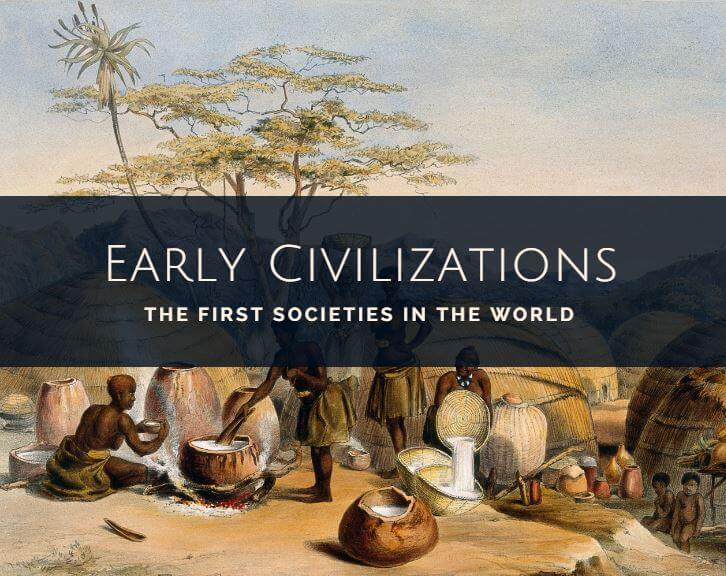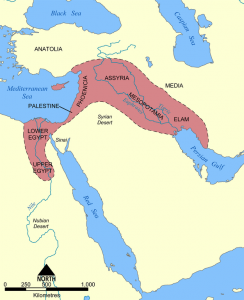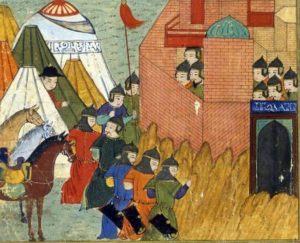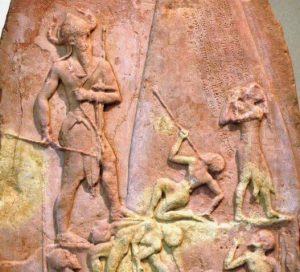The first historical civilizations, which we will call early civilizations, emerged around the base of the large rivers in the Middle East. It was in Egypt, along the Nile, and in Mesopotamia, around the base of the Tigris and Euphrates Rivers, where the first civilizations developed. As centuries passed, other people and empires emerged and replaced those that once existed, so one must also pay attention to the Persians, Phoenicians, and Hebrews.

Early Civilizations
Contents
In this area known as the Fertile Crescent, man discovered agriculture. The possibilities for the development of agriculture provided water and fertility to the land of the valleys of the rivers, making it possible to increase the production of food. With this, the population grew and a surplus of agricultural goods arose that allowed the exchange of food for other goods, thus giving a place for the birth of trade and the development and specialization of other jobs that were not related to agriculture.
Towards the millennium 4000 B.C. , the gatherings of people that inhabited these areas had been transformed from small villages into cities, whose organization was the birth of an administrative organization that saw to the establishment of laws and norms to improve the functioning of the city.
The need to document commercial trade and the need to introduce laws made the birth of writing possible.

The Sumerians were the first civilization that developed an urban system and a system of writing. They settled in an area historically known as Mesopotamia in what is today, Iraq. The first Sumerian cities, Ur and Uruk, date back to 3500 B.C.
The Sumerians, The First Civilization
It is possible that you’ve been asked “When did History begin?” To resolve this difficult matter, one must first understand the basic concepts that define the shift from the Prehistoric Neolithic Period to history as we know it. Simply put, one can say that the essential elements for this transition are the creation of urban centers and of writing as a method of communication. And so there was the first people that stood out above all the other cultures in their time period, they were the early Civilization of Sumer, cradle of history.
Origins and Background
Nothing can emerge spontaneously. To comprehend why the Sumerians achieved a high level of civilization, one must be mindful of two factors:
Geographic factors: The territories in which they settled fell between the Tigris and Euphrates rivers, south of modern-day Iraq. This area is the southern part of what is known as Mesopotamia (between the rivers) or the Fertile Crescent (For its crescent shape and its fertile soil). The existence of water was fundamental for the development of agriculture, and the utilization of brick as a construction material and as a form of transport for merchants across rivers and canals. However, this area totally lacked other important materials including stone, metals, and wood. This provoked a search in other places, such as Anatolia, Syria, The Caucasus, Libya, and the Zagros mountains. From this need for important materials, trade was born.

Social Factors: The crop surplus provoked specialization of individuals. It was no longer necessary for everyone to cultivate their own food. Thus, arose trade and craft. The best place for trade without a doubt was in the city. Products were created to meet the increasing demand for them. The city is also a refuge for the people against attacks. These changes provoked such social complexity that social classes started to develop according to individual wealth and utility. Great lords and priests came forth and quickly monopolized the power.
With these factors, we encounter the first pre-urban cultures towards 7000 B.C that already had crafting and pottery. The ethnic origin of the Sumerians is certainly intriguing since they don’t come from the Semite tribes that populate these lands. The more credible explanation indicates to us that the Sumerians were an evolution of the indigenous populations. Other theories say that they came from the area near the Caspian Sea or from India.
The culture called Obeid (Towards 4500 BC), developed in what could be called the first urban settlement, Eridu, that is well known by archeologists having government and temples, they also had big pottery, they also constructed canals.
Later appeared the culture of the city, Uruk, an authentic predecessor of the Sumerian Civilization. One could consider Uruk to be the first city-state (3500-3000BC), also it is where the most ancient writings have been found. Without a doubt as a response to the complexity of the urban organization, these first writings are related to the organization of marketplaces.
So then we encounter the first new culture that will supersede those that came before it in 3000BC. And that before this new social organization will come to be known as a civilization.
Sumeria
The culture of Uruk was imposing itself on others little by little, however, it didn’t become a great kingdom but instead it was a country formed from various city-states. Each city had a Ziggurat (Pyramid with stairs to observe the stars and also the home of the city’s God), a palace for the king, a temple and agricultural settlements on the outskirts. Its history is divided into three initial periods:
Pre-dynastic Period (2900-2300 BC)
In this first period, the violence between the cities is of note even though they never came to destroy each other completely. The most important cities from which we have preserved archaeological findings are Uruk, Ur, Kish, Nippur, Umma, and Lagash. Amongst these, Kish stood out as the spiritual center of Sumeria. Per their religion, from this city would come the first king after the deluge. The throne was highly desired and whoever possessed it would have ultimate authority over the conflicts between the cities.
The city from this era that we know the most about is Lagesh, thanks to the great written accounts and archaeological findings, even though it wasn’t the most important. It was situated in the Euphrates river bank and, like all cities, had a large agricultural population. One of the principal characteristics of this city-state was the constant war between it and its neighbor, Umma, of whose confrontations we have many written accounts. So, we know how the ruler, Eanatum, took over Umma, offering it as tribute and overtaking vast territories. With that victory, he was declared Ensi (Lord) of Umma and Lugal (king) of Kish. He also led military and commercial expeditions to areas in northern Iran.
Years later, internal confrontations came up between the palace and the temple, in other words, the power of the prince against that of the priests over the city’s economy. In continuing the wars against Umma, the city suffered a great degradation in increasing social pressure between the upper class and the lower class to maintain the endless conflict. Finally, the situation became unsustainable, until a new governing body, Urukagina, created a series of reforms that economically relieved the less-favored population. In addition, it instated a series of laws that protected the less-favored population from abuses. It is also worth highlighting the preference of fines that opposed the widespread “eye for an eye” of the condemned. This removed power from the priests of the temple.
However, towards 2300 BC, the city of Umma had recovered, a prince called Zagasi conquered Lagash. This ended 300 years of war. No only did he conquer their eternal rival, but he also took the cities of Ur, Kish, and Uruk, bringing forth the expansion until the region of Syria-Palestine. From this, he earned the title of “Lugal-Zagesi”. Despite having created a type of reign, the time of the Sumerians was going to change radically by the appearance of a new external factor… The Akkadians.
The Akkadian Empire (2300-2200)

To the north of Sumeria was populated by Semite populations for thousands of years. These were absorbed culturally, in part, by the Sumerians in the slow process of cross-breeding. The Semites settled little by little in the cities to the north (in Babylonia), especially in Kish. This continued until a man appeared from the lower class called Sargon who rose in power on the city around 2300 BC, before the weakness of the Sumerians from the internal wars. Quickly, Sargon from Akkad, the name of the city that he selected to be the capital, took over all of Mesopotamia, creating an empire from the Arabic Sea to the shores of the Mediterranean, passing through Syria and Asia Minor, an extension never overtaken by anyone before, and through which Sargon is considered the first emperor in history. In fact, he was called “King of the Four Regions”. All to say that all the world was united by his kingdom.
This new political entity needed a new organization. The empire was divided into provinces with governors. In addition, a type of mail service was created for a better administration and control of the provinces. These conquests were possible thanks to the creation of a regular army and the application of new military tactics. Also, the army was utilized for military campaigns with economic and commercial objectives, as we know, raw materials were scarce in this region. In those years, the Sumerian-Akkadian culture was merged into one society, though the Sumerians never wanted to submit to their northern neighbors.
Towards 2150 BC, the pressure of a new wave of nomadic people, the Guti tribe, from Kurdistan. The attempts to achieve independence by the Sumerian people in the south brought the empire of Sargon to its knees.
Neo-Sumerian Period or Ur III (2200-1800 BC)
The fall of the empire was rapidly taken advantage of by the Sumerian cities to return to being city-states. Towards 2100 BC, a governor in Ur, in the moments under control of Uruk, successfully expelled the Gutis from Babylonia and from northern Sumeria. After this success, he rose up as the king of Uruk and completed his conquest of Mesopotamia, proclaiming himself king of Sumeria and Akkad. His name was Urnamu, and with him began the dynasty called “The Third Dynasty of Ur” or simply “Ur III”. In his reign, the territory was divided into providences, creating a central state that overcame the Akkadian empire. Even so, the city-states were granted a great deal of autonomy. For the first time, the administration was divided into a civil power (lead by the Ensi) and a military power (Shagin), which was created with the power in the times of war. In addition, Urnamu is known for having created the first “Code of Laws” written that we know of (Preserved in pieces).
With this dynasty, the Sumerian culture experienced an extraordinary renaissance that vastly surpassed times that came before it. The kings were characterized by their diplomacy and political ability. Urnamu’s son, Shulgi, brought great stability and a time of prosperous peace that was translated into great accounts by public works, and above all, he brought forth a magnificent bureaucratic machine. The administration was made more professional, even including hereditary positions. The unique military incursions were carried out to maintain the commercial routes that supplied them with raw materials, those of which were controlled by the state. The Sumerian King of this time was more like the Akkadians than to the ancient princes of the Pre-dynastic period, all to say, a great central power that almost led to the deification of the monarch.
On a cultural level, the Sumerian early civilization had reached its “Golden Age” with respect to written works and the arts. Not only were there commercial records, but also writings from poets and scholars. They highlighted historical epics like the life of “Gilgamesh”, authentic predecessor of the hero prototype.
However, towards 2100 BC the empire’s days were numbered. Some cities on the peripheral were made independent (Isin and Lasra), in addition, the exhaustive economic pressure over the agricultural society created a great upset in the population. With this, a neighboring king, submitted by the Sumerians, Elam, took advantage of the weakness of Ur to take over it together with the greater part of the empire. But the final trigger of the disappearance of the Sumerians was the new incursion of Semite settlers, the Amorites, who little by little were taking possession of Mesopotamia. Only Isin and Larsa remained until the Amorite king of Babylonia, Hammurabi (famous subsequently for his code of laws), conquered them around the year 1750 BC.
With this, the Sumerian world disappeared forever, however their influence was such that the people, kingdoms, and subsequent empires that were settled in their territories finished adopting the greater part of their culture, with an emphasis on their writing system.

The Sumerian Culture
The reasons that the Sumerian culture survived past its people would have to be sought in the exceptionality of the culture itself. The Sumerians were the model to follow for the subsequent empires, above all, for the Babylonians and Assyrians. They were considered the mother of culture, including the Sumerian-Akkadian language, that was preserved as a sacred language. They were for Mesopotamia as the Greeks and Romans were for Europe. Also, the influence they had on the Jews is reflected in the Bible through the known references to Eden, the world deluge, the tower of Babel, and the confusion of languages etc. These circumstances that refer to what was the world of Sumeria, the origin of the world is not the Jewish God, it is the Sumerians. We see their most important characteristics.
Society and Religion
Sumerian society was conditioned in great part by their religious conception of the world. The great natural catastrophes that they suffered every so often (droughts and floods), made them see that they were not the center of the universe. Man was made to serve the gods, in order to make the gods benevolent towards them. With this mentality it is easy to understand the power that the priests had. The temple markets were alone the wealthiest by donations and by harvest of the surrounding lands, which were considered land that belonged to the gods. The temple and the clergy were an independent economic unit that organized their own trade, land, and scribes.
The civil power that was in the hands of the prince, which never came to be deified until the period of Ur III. They were, however, the supreme judge and military chief of their territory. It is hoped that from him would come protection and public construction for the benefit of the city. The palace that he lived in was the economic and administrative center, from which the city-states were governed.
The administration was directed by a minister of the prince, who organized and distributed the taxes, organized military expeditions and controlled the marketplace and the scribes, the few that knew how to write.
The greater part of the population of the city was dedicated to the agriculture. Also there were merchants and artisans. Slavery was not very common, but it existed. It mostly consisted of prisoners of war or debtors.

The Sumerians were great builders, however, the little use of rock (there were no quarries) and the common use of brick caused the structures to deteriorate over the millennia. The main building was the temple and the Ziggurat, home of the God of the city and from where the stars could be observed. Sumerian Cosmology was very complicated and dedicated to the interpretation of the desires of the gods, to them, the universe was a mess.
Construction with mud made it so that they never came to utilize stone columns. With mud, one must throw everything away and start over if they want to augment or change any part of the building. So, they built upon the remains of the previous structures. After centuries, the land was piled up with remains and it gave the landscape a common flattened characteristic, the “Tell”, in other words, mountains that were ancient cities.
What has come in abundance to us has been silverware and the relief of stone. Thanks to these elements, we know the greater part of the life of the Sumerians. The statuettes of offerings were very common and represented to the people prayer. The seals and reliefs of stone have preserved for us the type of life that they lived from work in the fields to life in the city to war.
The Writing System
The legacy of the Sumerians is important in many aspects, but the one that stands out most without a doubt was the writing system. The Sumerian Language did not have relations with any other from its time period. There had not been any vocabulary in the world that came close. It was an agglutinative language (like Turkish or Finnish), that is to say, a word consists of a root that expresses a concept and an participle that gives it a meaning. Also words were formed with two roots. (Lu=man gal=great lugal=great man=king.)
The written language properly spoken appeared around 3500 BC in Uruk, in being an area with a lot of mud, they quickly realized that the best way to write was on tablets made from this material, later they were baked to harden. At first there were pictographic writing system, as to say, they tried to reproduce as closely as possible the thing or action they wanted to express. For the cases that could be confusing, they attached another image, with time this image with its auxiliary meaning was only associated with its phonetic value, created words in itself.
The following change in pictographic writing was due to the use of tablets for writing. At first they wrote with a small reed continuously with straight and curved lines. However, quicly they realized that in mud it was much easier to write by pressing into the tablet with a small wedge that made an incision. From here came the name that we use to reference this type of writing: cuneiform. Now they could only write with straight lines, although they were trying to reproduce the object or the verb, they acquired a peculiar form that with the passing of time, transformed them into words that no longer looked like the original pictograph. A curious characteristic of this language is the dialects. Utilized according to the social category of the speaker.
The success of the power of communication in a lasting form and certainly not only utilized for administration and trade, even though this was 90% of found written material. Towards 2700, rich literature was written that even though it was sufficiently monotonous, it had varied themes. In fact, the literary motives of the Deluge being a punishment of mankind, the search of fame by the hero Gilgamesh, the inferno, fables, proverbs…etc appeared inside this civilization.
With the Sumerians appeared what we call Civilization. With them appeared as many positive features as negative features of our type of society. Close to the year 3000Bc also appeared other renowned civilizations like Egypt, China, or the culture of the Indus, however, Mesopotamia was given the right circumstances such that these people would be the first to become the true “chosen people”.
